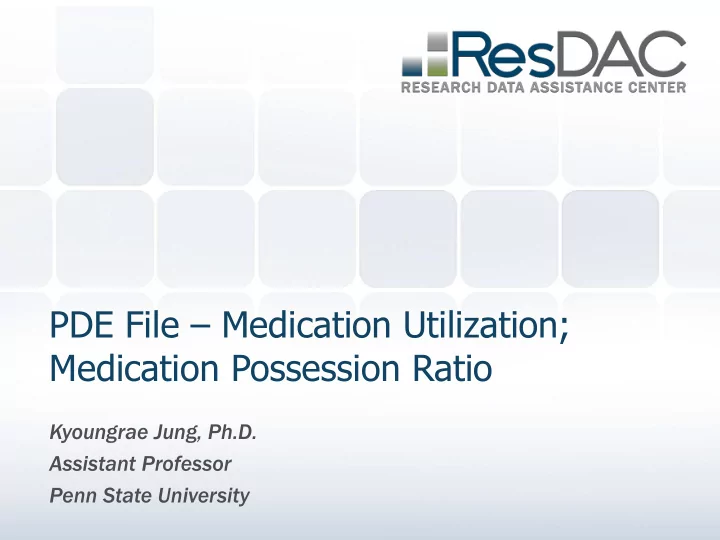

PDE File – Medication Utilization; Medication Possession Ratio Kyoungrae Jung, Ph.D. Assistant Professor Penn State University
Outline PDE variables related to medication utilization Measures of medication utilization based on PDE records 2
PDE Variables Related to Medication Utilization (I) Product Service ID (PROD_SRVC_ID) ˗ Identifies the dispensed drug using NDC Variables associated with Product Service ID ˗ Brand Name (BN) ˗ Generic Name (GNN) ˗ Need to be spelled correctly 3
Identifying Therapeutic Class If you are interested in examining a “therapeutic class” (e.g., anti -diabetics, anti-hypertensives, statins etc), identify all NDCs for the therapeutic class of interest ˗ From a proprietary data-base (e.g., Medi-Span) ˗ Use Product Service ID (PROD_SRVC_ID) If you know generic names of drugs, you can use Generic Name (GNN). ˗ Spell out correctly 4
PDE Variables Related to Medication Utilization (II) Prescription Service Date (SRVC_DT) ˗ Prescription initiation date Prescription Days Supply (DAYS_SUPLY_NUM) ˗ Prescription amount 5
Prescription Days Supply Key variable to construct medication adherence measures Median/Mode: 30 days Distributions: ˗ 30 days: 66.85% ˗ 1 – 29 days: 19.9% ˗ 31-100 days: 13.24% ˗ 101-180 days: 0.01% Records with 0 or >180 may be found (<0.01%) 6
Measures of Medication Utilization 7
Measures of Medication Utilization 1. Whether a recommended medication is used ˗ Can be used for a population with a specific condition » Requires information on diagnosis » Medicare Part A/B claims data are needed to construct this measure based on PDE records 8
Measures of Medication Utilization 2. Medication adherence ˗ Captures whether a patient takes a prescribed medication according to a schedule ˗ Various measures have been used ˗ % of time with Rx vs. % of time without Rx ˗ Specified time period vs. during refill intervals 9
PDE Data Fields to Construct Medication Utilization Measures Variable Name Description Why Needed PROD_SRV_ID Product Service ID Identify Rx or Rx class SRVC_DT Rx fill date Initiation (fill) dates DAYS_SUPLY_NUM Rx days supplied Amount of Rx 10
Measures of Medication Utilization Based on PDE Data Measure acquisition of medications not consumption Cannot measure timing of taking medications Good for long-term follow-up 11
Measures of Medication Adherence Measure Description Terminology Measures of Proportion of -Medication Possession Ratio (MPR) medication days supply -Proportion of Days Covered (PDC) availability during a -Medication Refill Adherence (MRA) specified -Refill Compliance Rate (RCR) time period or -Continuous Measure of Medication over a period Acquisition (CMA) of refill -Compliance rate (CR) intervals -Adherence Ratio Hess, et al. Ann Pharm July/Aug 2006 Andrade et al. Pharm. and Drug Safety, 2006 12
Medication Possession Ratio (MPR) Most commonly used measure of adherence Proportion of days supply during a given time period Can be defined differently depending on how a time period is specified 13
Medication Possession Ratio (MPR) Two main definitions: 1) MPR 2) MPR m : MPR modified 14
Specifying a Time Period Fixed follow-up period (e.g., 1 year) ˗ With a fixed time period, numerator only (duration of therapy) can be used as an adherence measure Evaluation period ˗ From the first fill to the end of the follow-up period ˗ Denominator varies by patient 15
Does Denominator Matter? MPR vs. MPR m Detail of Each Fill (4/19/09-4/18/10) Adherence Value of Fill Day Days Supplied Days in Interval Different Measures April 27 35 26 MPR: 0.323 May 23 35 48 MPR m : 0.90 July 10 8 4 July 14 30 42 August 25 10 237 TOTALS 118 357 Source: Hess, et al. Ann Pharm July/Aug 2006 (Modified Table 1) 16
Choosing an Adherence Measure Study goal and relative advantage (Andrade et al., 2006) ˗ Whether therapy is generally prescribed for a defined period only or for a life-long condition should determine how to treat early termination (e.g., MPR vs. MPRm) ˗ Dichotomous measure may be used if an appropriate cut-off (of adherence) can be justified 17
Choosing an Adherence Measure Data availability and cost ˗ MPR and related measures are easy to calculate (& interpret) 18
Issues to Consider When Constructing Adherence Measures Over-supply Medications provided during hospital admissions Taking multiple medications for a given condition - Metformin & sulfonylurea for diabetes - Diuretics & ACE inhibitors for hypertension 19
Example of “Excessive” Supply Detail of Each Fill (6/16/09-6/15/10) Fill Day Days Supplied Days in Interval June 19 35 21 July 10 35 35 August 14 30 30 September 13 30 30 October 13 30 31 November 13 30 35 December 18 30 15 January 2 30 38 February 9 30 26 March 7 30 5 March 12 30 58 May 9 30 36 June 14 30 1 TOTALS 400 362 20 Hess, et al. Ann Pharm July/Aug 2006
Handling Hospitalization and SNF Stay Medications provided during hospital admit ˗ Exclude hospitalized subjects ˗ Assume all Rx provided while in hospital, so add days to supply (numerator) or reduce interval (denominator) 21
Handling Hospital/SNF Stay: Example 280 days of Rx in 1 yr w/ 20 day hospital stay ˗ Ignore: 280/365=0.767 ˗ Add to days supply: (280+20)/365=0.822 ˗ Reduce total interval: 280/(365-20)=0.812 How addressed potentially changes outcome if adherence dichotomized (=1 if ≥ 80%) 22
Other Decisions: Multiple Meds for a Given Condition Create Rx-specific adherence & (unweighted) average ˗ Benefits: Summarizes overall adherence, simpler model ˗ Costs: Potentially misrepresents adherence of each Rx if vastly different 23
Other Decisions: Multiple Meds for a Given Condition Create Rx-specific adherence & model separately ˗ Benefits: Allows adherence to each Rx to be represented ˗ Costs: More complicated modeling 24
Other Decisions: Timing Measure adherence by year or by month? ˗ Person-year » Benefits: Simpler model if one year of data » Costs: May miss important within-year changes ˗ Person-month » Benefits: reflect realistic variation within a year » Costs: More complicated modeling 25
Recommend
More recommend